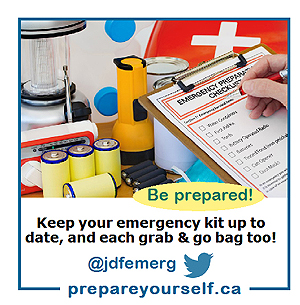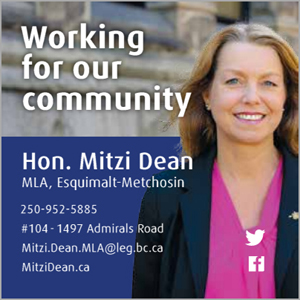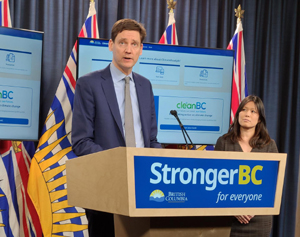
Tuesday February 21, 2023 | VICTORIA, BC
by Mary P Brooke | Island Social Trends
Historic provincial investments will support communities in preparing for the risk of natural disasters related to climate change, along with a new one-stop online platform to help people and communities better prepare for, mitigate and understand disaster and climate risks.
Today Premier David Eby along with Bowinn Ma, Minister of Emergency Management and Climate Readiness (EMCR), announced that the Province is committing a further $180 million to the Community Emergency Preparedness Fund (CEPF).
Funds will be distributed on by-application basis through the Union of BC Municipalities (UBCM). UBCM President Jen Ford shared the press gallery theatre stage with Eby and Ma today.
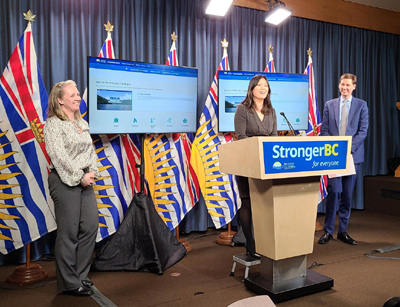
The funds come as the BC Government hastens to use up the 2022-2023 surplus before March 31 fiscal year end.
The funds will support projects that help local governments and First Nations prepare communities for the risks of natural hazards and lessen the effects before disasters happen.
Really hurt by disasters:
Premier Eby said that communities have been “really hurt by these climate disasters” of recent years, such as the 2021 Fraser Valley flooding and the heat dome.
In announcing the $180 million fund today he itemized the planning of evacuation routes and flood mitigation as two examples of work that can be done with the new funding.
Range of projects:
Speaking with Island Social Trends, Minister Ma easily rattled off what sorts of things the new funding can be used for: “There’s disaster risk reduction, climate adaptation, emergency operation centre training, emergency support services, extreme temperature risk mapping assessment and planning, Indigenous cultural safety training, public notification, evacuation route planning, volunteer training and fire department equipment training,” she said.
“But it’s the Climate Preparedness and Adaptation Strategy stream of the CEPF is really where the bulk of the money will go,” Ma quickly added. “Those are projects that involve small scale structural builds, where a lot of the other is planning or equipment replacement and so forth.” Dike upgrades, evacuation route planning, and building cooling stations or cooling infrastructure in case of heat waves are among other projects that can be undertaken with the funds, the first minister of this new ministry said today.
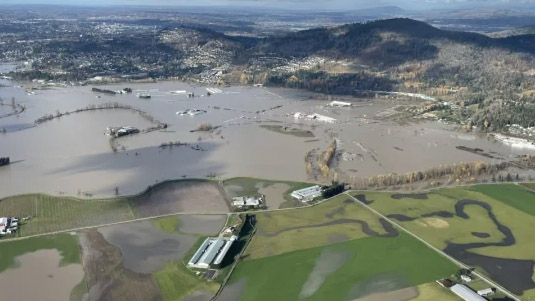
Municipalities would have projects they can bring forward. Ma said there will be “a mix” of shovel-ready projects and some new ideas in communities that are “still at planning stages”, now that the funding is available. “The importance of keeping investments up to meet that demand is absolutely critical,” said Ma.
“Each part of the province will face impacts from different types of extreme weather,” says Ma. Will she be looking for gaps, if a community doesn’t come forward?
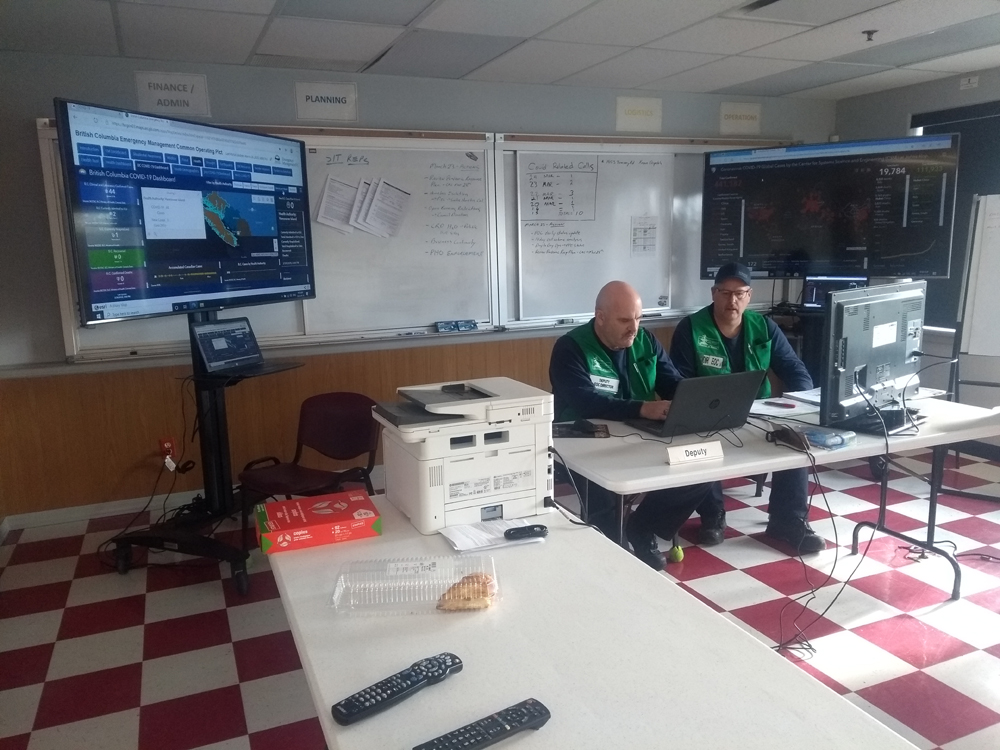
“This is only one part of the overall program that EMCR is going to be pursuing over the coming years and the years ahead. This is a fund provided for UBCM for communities to apply to. There will absolutely be more work, and we will continue to work with communities to figure out what’s needed out there,” the Minister said.
CEPF now at $369 million:
The new contribution brings CEPF’s total investment to $369 million since its establishment in 2017. The CEPF has historically funded projects like a new dike in Merritt, public cooling infrastructure in Victoria and planning for a tsunami evacuation structure in Tofino.
“BC has seen more than our share of climate disasters, so there’s urgency to be ready and equipped to minimize damage and recover quickly when the worst happens,” said Premier David Eby.
“New funding for projects in communities, combined with a new online hub of information resources for local leaders, will help us all be better prepared to face emergencies.”
UBCM eager to help:
“The CEPF program is helping local governments and First Nations prepare for climate related emergencies by funding projects that address a wide range of hazards,” said UBCM President Jen Ford.
“Accurate data is critical for mitigation and planning activities, and our members will be intent to utilize the ClimateReadyBC platform and provide input to support its development. I welcome the government’s continued commitment to improving emergency preparedness in BC’s communities.”
ClimateReadyBC:
In response to the growing number of climate-related emergencies in BC, the Province has launched ClimateReadyBC, which provides hazard and mapping tools, risk data and resources to help communities better prepare for future disasters and climate emergencies.
ClimateReadyBC is designed to be a hub for communities and people to use as an educational tool and as a resource for disaster preparedness.
People can visit the online hub to learn more about various hazards, such as floods, wildfires, extreme weather, tsunamis and earthquakes. Previously, this information was spread over different government websites. For example, the new online hub includes historic flood data, such as where and when a flood took place and the cause.
“Recent extreme weather events have caused a lot of destruction in B.C. and people are looking to our government to help keep them and their families safe,” said Minister Ma. “Through ClimateReadyBC and a historic investment in CEPF, we’re increasing the tools and the resources communities need to prepare for climate-related emergencies.”
ClimateReadyBC and CEPF support the Province’s Climate Preparedness and Adaptation Strategy. With a record investment in CEPF, more funding will be available for communities under each of the fund’s seven streams. The fund is also increasing to assist communities in dealing with and preparing for the effects of extreme cold, in addition to extreme heat. Additionally, the funding stream for disaster-risk reduction and climate adaptation will support structural projects, such as dikes and pump stations, with funding of as much as $5 million, increased from $2 million.
“People in British Columbia understand how important it is to invest in resilient communities and infrastructure so that we’re much better prepared for the ongoing impacts of climate change,” said George Heyman, Minister of Environment and Climate Change Strategy. “Our government is making record investments in climate adaptation measures and providing easily accessible information so people and communities can easily and quickly find the resources they need.”
Ongoing engagement with First Nations, local governments and other partners will drive ClimateReadyBC’s expansion and evolution. For example, this summer, the Province will add a provincial extreme heat-risk portal that will allow local authorities to add and edit cooling facility data and information in a centralized location. Additionally, data and tools on the portal will integrate with mapping platforms developed by the First Nations Emergency Services Society.
Since 2017, First Nations and local governments have been approved for more than 1,300 projects through CEPF that help communities mitigate and prepare for disasters and climate-related emergencies.

===== ABOUT ISLAND SOCIAL TRENDS:
Island Social Trends emerged in mid-2020 from a preceding series of publications by founder/editor Mary P Brooke and published by Brookeline Publishing House Inc, covering news of the Vancouver Island region, BC and national issues through a socioeconomic lens.
The publication series began with MapleLine Magazine (2008-2010), then morphed to a weekly print newspaper Sooke Voice News (2011-2013), and then into the weekly PDF/print West Shore Voice News (2014-2020). The news through this lens is now fully online at IslandSocialTrends.ca (since 2020).
ARCHIVES: POLITICS | EMERGENCY PREPAREDNESS and SAFETY



